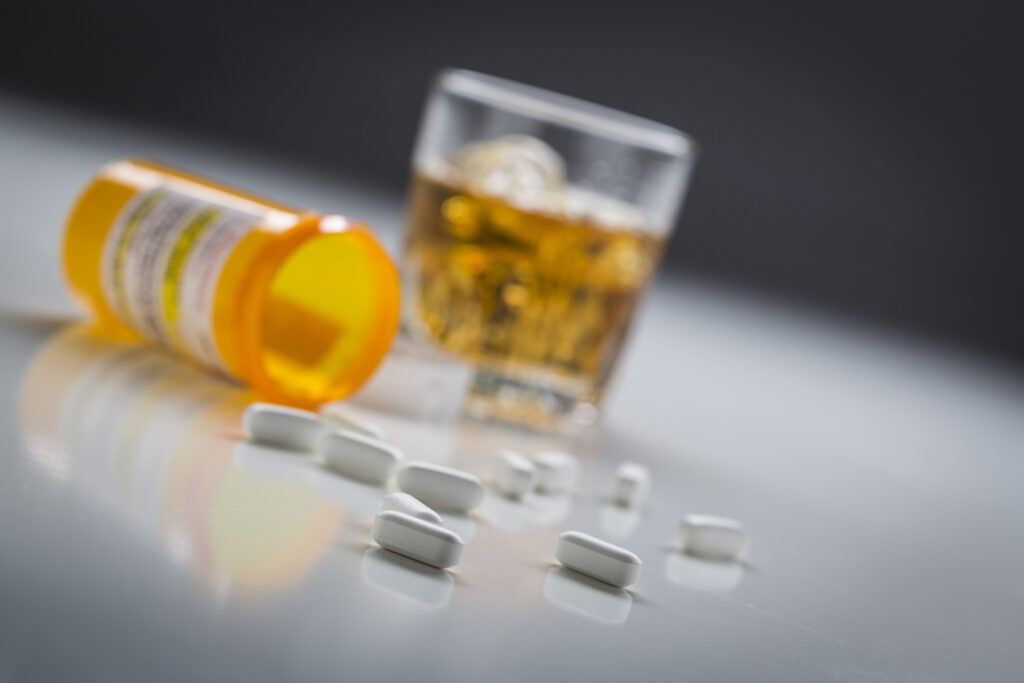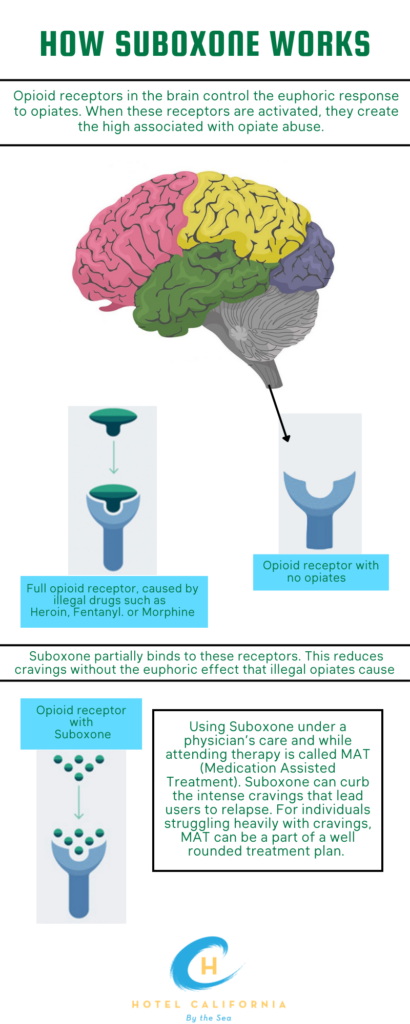Polysubstance Use: Suboxone and Alcohol
Polysubstance abuse is quite common among people who already abuse alcohol. Oftentimes alcohol is used to enhance or blunt out the unwanted effects of the other substance being abused. One drug used alongside alcohol is Suboxone. Suboxone and alcohol are both central nervous system depressants. When taken together, it can result in distressing effects such as respiratory depression, sedation, slowed heart rate and a high risk of overdose and coma.

Alcohol use disorder is a mental health condition that affects many Americans. It is characterized by the inability to stop and control drinking habits despite continued negative consequences. Alcohol interferes with how the brain operates and has an impact on a person’s behavior and mood. Alcohol abuse can limit cognitive thinking and rational thinking. It is also linked to heart-related conditions, and liver and kidney damage. For polydrug users, alcohol is often mixed with Suboxone.
Suboxone is a prescription medication that contains buprenorphine and naloxone. It is often used in medication-assisted treatment for opioid use disorder to help ease the painful withdrawal symptoms of opioid addiction. Suboxone is a partial opioid agonist and works by altering the brain receptors to reduce cravings for opioids and blunt their euphoric effects. Polydrug users often mix the two substances in an attempt to experience stronger intoxication symptoms. However, it can be dangerous and lead to respiratory depression and central nervous system depression.
More about the effects of Suboxone
Suboxone contains two main ingredients: buprenorphine and naloxone. Buprenorphine is a partial opioid. It works by reducing the painful side effects of withdrawal from opioids. Naloxone is a misuse deterrent and a medication used to quickly reverse the effects of opioid overdose. The combination of the two ingredients within Suboxone helps ease withdrawal symptoms as well as reduce cravings for opioids. When used per the recommendation of a medical health care provider, Suboxone is very safe and effective in treating opioid use disorder. It is most commonly prescribed as part of medication-assisted treatment.
When on Suboxone treatment for opioid use disorder, the drug tricks the brain into thinking it is still receiving opioids. Suboxone can remain in the body for up to 24 hours or longer, depending on various factors. Suboxone works by preventing cravings, easing withdrawal symptoms and reducing the risk of opioid overdose. Abuse of Suboxone can also lead to liver inflammation, liver failure and worsening of any liver conditions that already exist.
Despite not being as strong as other opioids such as heroin and oxycontin, Suboxone still has the potential to become addictive especially when combined with other mind-altering substances such as alcohol. The combination of the two drugs can lead to tolerance, dependence and addiction.
Mixing Suboxone and Alcohol
Any combination of polysubstance use can become problematic and lead to addiction. It increases the risk of overdose, addiction, relapse and long-term health dangers. There is an especially high risk of negative outcomes when using both alcohol and Suboxone. FDA guidelines warn of serious side effects when taking alcohol with Suboxone and it is generally not recommended to do so.

Side Effects of mixing Suboxone and Alcohol
- Sedation
- Severe drowsiness
- Dizziness
- Confusion
- Decreased awareness of surroundings
- Cognitive impairment – problems with memory, attention and decision making
- Physiological impairment
- Neurological damage
- Organ damage due to reduced oxygen supply
- Liver damage – abdominal pain, fatigue, jaundice and loss of appetite
- Kidney damage
- Cardiovascular disease – changes in heart rate and blood pressure
- Lung damage – respiratory depression due to severe sedation and decreased respiratory drive
- Loss of consciousness
- Changes in behavioral health such as the development or worsening of anxiety and depression
- Higher risk of alcohol poisoning and toxicity from the effects of suboxone on the system
- Higher risk of developing alcohol use disorder
- Higher risk of developing opioid use disorder
- Overdose, coma, addiction and death
Coma. The risk of coma increases significantly when mixing the two substances. Alcohol and Suboxone are both central nervous system depressants. They increase sedative effects such as drowsiness, slowed or stopped breathing and the inability to stay awake. Slowed breathing can deprive the brain and other organs of oxygen they need to function, thrive and survive. This leads to brain damage and other organ damage. When this happens, a person is more likely to be at risk for coma.
Drug relapse. Recovery and treatment for opioid use disorder can be very difficult to overcome. Opioids itself can become very addictive. When adding alcohol into the mixture, it can further alter the brain chemistry and increase a person’s risk of depression and anxiety. When a person develops symptoms of depression, they will often feel the need to self-medicate with substances in order to manage their uncomfortable feelings. That means, going back to using opioids in order to avoid those uncomfortable feelings. Worsening poor mental health is a known relapse risk.
Reduced inhibitions. Polydrug use of alcohol and Suboxone further slows down brain functions that regulate and manage cognitive functions such as thinking, decision making and behavior. When you are intoxicated on both alcohol and Suboxone, a person might do things or participate in risky or dangerous activities that you would never do while sober.
Poor or worsening physical health. Long-term alcohol use can cause a whole host of negative outcomes. Conditions such as cardiovascular disease, high blood pressure, heart attack and stroke. Alcohol abuse has also been linked to breast cancer, liver disease, throat and colon cancer. The overall immune system is weakened and users will use the ability to fight off infections. When alcohol is added to Suboxone use, the negative effects of Suboxone and alcohol are exacerbated.
Check Your Insurance Coverage for FREE
Find out if your insurance covers addiction treatment in minutes. We accept most insurance!
Factors that contribute to Polydrug use of Suboxone and Alcohol
- Self-medication – Oftentimes, those with mental health conditions such as depression, anxiety or bipolar disorder have difficulty managing their emotions and negative feelings. They turn to alcohol or other drugs such as Suboxone, which is an opioid, to suppress, blunt or block out their feelings to help them manage their condition.
- Curiosity – Sometimes, users are genuinely curious about what it might be like to experience mind-altering effects produced by alcohol, Suboxone or a combination of both. This often stems from boredom, and social or peer pressure.
- Lack of awareness – Most times users of both drugs are unaware of the potential dangers of mixing the two substances.
- Demographics – Young people, men, people with a history of substance abuse and people with a history of mental health conditions are more likely than others to participate in polydrug use, which can lead to drug abuse and addiction.
- Lack of support – Those who lack a support system when it comes to treating substance addiction are more likely to develop other addictions or even a polysubstance addiction such as Suboxone and alcohol.
Reach out to Hotel California by the Sea
We specialize in treating addiction and other co-occurring disorders, such as PTSD. Our Admissions specialists are available to walk you through the best options for treating your addiction.
Are you looking for Treatment for Substance Abuse?
Suboxone and alcohol is a popular polydrug combination. Suboxone can multiply the effects of alcohol just as alcohol multiplies the effects of suboxone. Both substances on their own can become addictive. When taken together, these substances can cause dangerous side effects including overdose, coma and death. Overcoming an addiction to substances can be difficult. Overcoming a polysubstance addiction can be even more challenging. Hotel California by the Sea provides the support, tools and resources clients need to stop their polysubstance abuse.
We provide treatment at all levels of care including drug and alcohol detox, inpatient residential treatment, partial hospitalization program and intensive outpatient programs. Clients receive dedicated treatment plans throughout each level of care.
We also utilize the most effective and latest evidence-based treatment methods, which include cognitive behavioral therapy, dialectical behavioral therapy and marriage and family therapy. We specialize in treating co-occurring mental health conditions that often present alongside a substance addiction. Hotel California by the Sea is dedicated to helping our clients overcome their addictions and live a happier and healthier life in sobriety and recovery.
References:
https://zinniahealth.com/substance-use/suboxone/with-alcohol
https://www.healthline.com/health/drugs/suboxone-interactions
https://www.dhcs.ca.gov/individuals/Documents/MAT_Use_One_Sheet_Opioid_Alcohol_Web.pdf
https://www.nationaladdictionspecialists.com/dangers-of-mixing-suboxone-and-alcohol
https://www.bicyclehealth.com/suboxone-faq/how-does-suboxone-interact-with-alcohol
